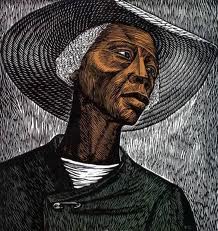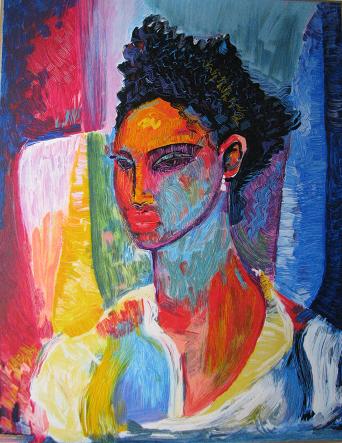OUT STOCK
Large Magnets
4.25″ x 5.25″
Beautiful Artful Large Fridge Magnets
Back to Art for Sale

Sharecropper
by Elizabeth Catlett
Hand-colored linoleum block print
Signed and Numbered by Artist
Size 18″ x 17″ Approx
Sharecropper reveals Elizabeth Catlett’s lifelong concern for the oppressed and the dignity of women. The print focuses on a female farm worker whose face, made rough and leathery by years of toil, is nonetheless determined and commanding.
After the Civil War, many former slaves became sharecroppers, or farmers who worked on rented land and received an agreed share of the crop as payment. This economic system trapped many of these African Americans, as well as white workers, in a cycle of poverty. Set in the 1950s, Catlett’s Sharecropper refers to the injustices that this unfair system exerted on the poor. Emphasizing the triumph of the worker over her harsh conditions, Catlett represented this poor, anonymous figure with the strength, dignity, and heroism generally reserved for individuals of power.
Catlett, a sculptor and graphic artist, has lived and worked in Mexico for many years. Born in Washington, D.C., she attended Howard University and the University of Iowa. In 1946, Catlett traveled to Mexico, where she worked with the People’s Graphic Arts Workshop (Taller de Gráfica Popular), a group of printmakers dedicated to using their art to promote social change. Catlett became a Mexican citizen in 1962. She became the first female professor of sculpture at the National Autonomous University of Mexico in Mexico City, a position she held until retiring in 1975.
.

Make Offer – Ask Question
Extremely low offers will not be considered. Please do not make offers if you are not serious about buying this item.
An October Gallery ArtPro will respond to you as soon as possible.
If you prefer a telephone follow up, please leave your phone number.
Price $25
I Am Black I Am Beautiful T Shirt
XLarge
Try on our classic, loose-fit T Shirt
Standard 5.3-ounce, 100% preshrunk cotton tee.
Offered at $25
Back to Art for Sale
.
Price $25
30 Years of October Gallery T Shirt
XLarge
Try on our classic, loose-fit T Shirt
Standard 5.3-ounce, 100% preshrunk cotton tee.
Offered at $25
.
Send us a message or post a comment in the box below
Your message has been sent
Back to Art for Sale
.
Price $7.50
Large Magnet
5.25″ x 4.25″
Beautiful Artful Large Fridge Magnets
Offered at $7.50
.
Back to Art for Sale
.
Price $7.50
Large Magnet
Size 5.25″ x 4.25″
Beautiful Artful Large Fridge Magnets
Offered at $7.50
Back to Art for Sale
.
Price: $25
30 Years of October Gallery Coffee Mug
11 oz Mug
Start your day off right with an artful coffee mug made just for you.
Offered at $25
Price: $17
Black Bold Beautiful Coffee Mug
11 oz Mug
Start your day off right with an artful coffee mug made just for you.
Offered at $17
Price: $15
Funeral Procession
by Ellis Wilson
Open Edition Offset MINI Print
size 8.5″ x 11″ Approx
Funeral Procession is the name of a painting by Ellis Wilson, which went from obscurity to notoriety in 1985, when it was featured heavily in the plot of a season 2 episode of the hit TV series The Cosby Show. In the episode, Mrs. Huxtable wins the painting at an auction and pays $11,000 for it. She states that the painting was made by her “great-uncle Ellis”. At the end of the episode, Dr. Huxtable hangs the painting over the family’s living room mantle, where it would stay for the remainder of the eight-season series. In real life, the painting is displayed as part of the Aaron Douglas Collection at the Center at Amistad Research Tulane University in New Orleans, Louisiana. Ellis Wilson was born on April 20, 1899 in Mayfield, Kentucky, and died on either January 1 or 2, 1977. In real life, the most he ever got for one of his paintings was about $300.
Offered at $15

Price: $on Request
Adora
by William Tolliver
Edition A/P 5/35
Hand Pulled Serigraph
Signed by the Artist
Size 24″ x 30″
Artist Bio: 1951-2000 – Tolliver spent more than 30 of his 48 years perfecting his skill as a painter. Today, William Tolliver’s art is collected worldwide. Tolliver’s style freely combines the color of Chagall with the solid compositional principles of Cezanne and the mood and forms of Modigliani and Picasso. Tolliver’s words of wisdom for the young artist were, “I would urge an art student to go to school and learn the fundamentals, because to know the fundamentals is to know the technical aspects of blending colors.”
In an age when the rules of art had either been abandoned in favor of an anti-formalist attitude or had been institutionalized in academic study, William Tolliver emerged as a brilliant self-taught artist -a Mississippi-born Renaissance man whose creative intelligence combines the study of formal structure with an innate sense of human observation. Far from the marketplace of the New York City art world, Tolliver arose during the mid-1980’s a brilliant regional talent, an individual impelled by a desire to capture the landscapes and peoples of his native deep South. Whether dealing with everyday workers or back-alley jazzmen, he conveys a universal message through sconces of the common human experience. While plaintive in mood, Tolliver’s works evoke compassion with an underlying sense of expressive emotion. “I could draw on a lot of sad and depressing things from my life, but I’d rather emphasize the positive.” An artist of insight and natural ability, Tolliver is a deliverer of an artist message imbued with unique expressions and spiritual enlistment. Tolliver was born in Vicksburg, Mississippi. Although his mother worked in the cotton fields by day, she found time to rear and help educate 14 children. To stimulate their interest in learning, she often challenged William and his older brother to drawing contests. Discovering William’s talent, she borrowed art books from the library that exposed her son to the works of the European masters. His astute observation led him to study subjects from books, black-and-white photographs, nature, comics, and family members who posed as models. Since the local public schools did not have an art curriculum, Tolliver continued his course of self-study. From inexpensive dime-store watercolor sets purchased with money earned by mowing lawns, Tolliver learned to mix and blend colors by using a paint-by-number kit. Using this system he experimented with mixing color and skin tones and by the age eight was able to create academically correct paintings.
Offered at $on Request

Make Offer – Ask Question
Extremely low offers will not be considered. Please do not make offers if you are not serious about buying this item.
An October Gallery ArtPro will respond to you as soon as possible.
If you prefer a telephone follow up, please leave your phone number.